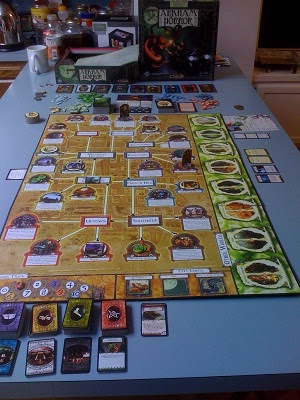A game that I heard great things about and finally got an opportunity to play (thanks to my wife for the present) was Forbidden Island
In Forbidden Island, each of the players takes on the role of an adventurer on an ancient deserted island. The adventurers are attempting to discover the 4 ancient artifacts on the island, but lo and behold, the island is booby-trapped and is starting to sink. In order for the adventurers to win, they must collect the 4 artifacts, all return to the helicopter pad, and then take off. How a normal turn will work while attempting to accomplish this goal is as follows: take 3 actions (move, trade cards, return a tile to a non-flooded state), draw 2 cards (hoping to not get a "Waters Rise"), and play as the board to flood a certain number of tiles. (Yes, this is very Pandemic-ish).
The first pro of Forbidden Island is that it is simple to learn, and quick to play (and can be played with all ages - the game says 10 and up, but if you have smart children, you could probably do it at 8). The instructions are only about 5 half-sized pages, and the game claims to take 30 minutes. As opposed to lots of games that horribly lie about estimated time, this is actually a pretty close estimate. Fortunately, whereas many games equate "quick" with "lame" or "non-strategic", Forbidden Island actually has enough depth to it that you do not get bored after the first play, but you actually want to play again. I will say this again: this is actually a quick game with depth to it. Hoorah, we have found one!
The second pro is that it has an adjustable difficulty level. When first learning how to play on Novice, we smoked the game. Had this not been adjustable, I would have dropped the game as quickly as I could. However, when we were looking for a real challenge and played it on Legendary, we lost. As bad as it sounds, I'm glad we lost. If we had won each time we played, I would have also moved on from the game. With the varying difficulty, there is enough challenge to keep me coming back to play it more.
The final pro I will mention is that the game itself (components) are very high quality compared to the cost. It comes in a nice tin, and the artifacts are quality molded plastic, and the list price is around $15. Honestly, this is what scared me off from the game at first, and why it took me so long to try it. I thought that the game must be pretty lousy for $15, but I'm glad to say that I was wrong.
Now for the cons: the players did not seem especially balanced. Here's an example: the pilot versus the diver. The pilot is able to, once per turn, take one action to move anywhere on the board. The diver is able to move through sunk tiles. If it were me, I'd rather have the pilot every time.
My next con is that there seemed to be too many times in which you had nothing to do with some of your actions. Obviously this happened more on the easy difficulty settings than the harder ones, but it would've been nice if there were a few more things you could do. (Yes, I realize that I bragged about the depth of the game a lot, but this still bothered me.)
The final con was related to the hand limit. This is especially problematic in a smaller game - such as 2-player. The hand limit is 5 cards. There are 5 copies of each artifact card in the deck and you need 4 of them in order to discover the artifact. The problem comes in when you wind up having two different artifacts that you have multiple copies of. You will have to throw away enough copies of one of the artifacts that you will not possibly be able to discover it until the second time through the draw deck. This means that no matter how well you played, because of the hand limit and unfortunate drawing, you are guaranteeing that you get at least 4 "Waters Rise" cards (the number in the deck). Since one of the ways you lose is by having the waters rise too many times, this just seemed frustrating as you may wind up losing in a way that could not possibly be avoided if the "Waters Rise" come up the second time through the deck before the artifact cards that you needed.
Overall, Forbidden Island gets an 8.0/10. I would recommend playing Pandemic first, but honestly, if you do that, it may ruin you for Forbidden Island. It is really just Pandemic-lite in my opinion. My other final point of note is this: you will wind up playing on Legendary (as we did) if you want any kind of challenge. Just know this going in so that you won't be disappointed.
If you want another opinion, check out the Board Game Family's Forbidden Island Review; or if you want to read about other cooperative games, check out Flash Point: Fire Rescure, Defenders of the Realm, and Yggdrasil.
Josh's note after initial posting: after more plays of this game, I must give it credit that sometimes it can be quite challenging even on the easier settings, as I found myself challenged and even badly defeated on "Normal" mode.
















